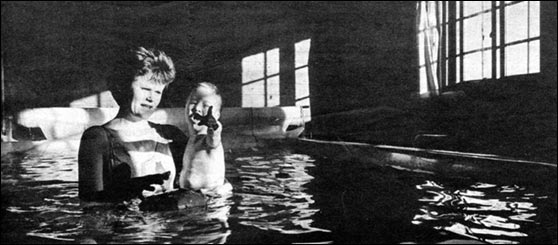|
A look at Rushden Hospital’s past is like thumbing back through the pages of health service history. The present buildings perched high on a windy site above Wymington Road have witnessed a stream of patients passing through – many with diseases now defeated by medical science, others with conditions which remain a present-day problem.
The uses of the motley collection of buildings, grouped around the imposing Victorian Rushden House, have changed over the years.
Opposite ends of the age spectrum find help at Rushden Hospital – mentally handicapped children and elderly adults, many of whom are mentally ill.
Around 100 staff are on the premises, day and night, to give round-the-clock nursing care in a collection of airy buildings which date back to the time the hospital was a tuberculosis sanatorium.
Touring the hospital’s Sharwood, Hensman, Crane and Colton wards on a sunny day it is easy to see why the site was originally snapped up by the county’s Administrative Council for a mere £7,000 for conversion into a sanatorium following its use as a German prisoners’ camp in the First World War.
In those days treatment was crude – plenty of fresh air and exercise – so there were bowling greens, a tennis court and putting on the 22‑acre site.
Huts were built to take patients suffering from the county’s White Plague – tuberculosis was particularly rife due to conditions in the local boot and shoe industry.
The most acutely ill were nursed in Rushden House itself and the sanatorium took its first patients in September, 1921. Brick buildings, ultra-modern for those days, replaced them in the late 1930s and these still house the main body of the hospital today, though the administration offices are still in the old house at the hub of the site which was built as a family home in 1870.
As tuberculosis declined new functions grew up in the buildings which were adapted, including a skin department which remained there until moving to Kettering General in 1981.
Chest patients suffering from lung cancer, chronic bronchitis, asthma and similar conditions also arrived and remained at the hospital until the beds were removed to Kettering General in 1979.
The children came in 1968 as parents were having to travel long distances for medical support. Colton ward was converted to take 20 youngsters with varying disabilities and the work there continues today – with the addition of a swimming pool – to give parents a break from caring for the mentally handicapped child. During the day most of the children go to Fairlawn School.
A social services day centre for the elderly, Cordwainers, opened in Rushden House in 1980 and has continued to provide support there ever since.
And future developments in the imposing building include the conversion of the former billiard room into a new day hospital.
The hospital is run by Kettering Health Authority and is part of the district’s provision for the elderly and mentally handicapped.
Despite government policy to de‑institutionalise the care of handicapped elderly and mentally ill people, moving them out into the community, administrator Pia Herbert says there is still a place for hospitals like Rushden.
|
